A word picture of the centre of Harpenden, drawn form the details of the 1871 census, the Parish magazine and old newspaper cuttings. Also used were: “Thirty Three Years at Harpenden” by Miss Vaughan, and Edwin Grey’s “Cottage Life in a Hertfordshire Village” and his “Rothamsted Reminiscences”.
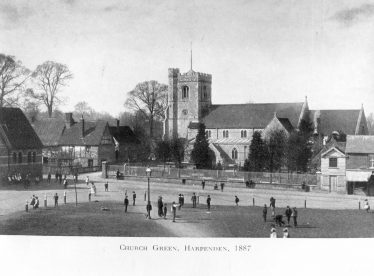
Church Green – a little later – in 1887
Of those people living in the village centre in 1871 – the ordinary man or woman in the street – there is little record apart from a name in the rate books, an entry on a census form, a tombstone or Parish Register. They made no great name for themselves for the most part, and it is ‘as if they had never been’. However, by piecing together various snippets of information from parish magazines, old newspapers and published records of village life, it is possible to ‘people’ the village and to see the types of people who made up the community in those years.
It is reasonably simple to know where they lived; indeed some of the houses are still to be seen. Of those houses that have gone, many photographs exist so as to be able to build a picture of the village as it was then. Life was still, for the most part, bound to the agricultural pursuits of the neighbourhood as far as the men were concerned, and few women were not involved in some way with the straw plait industry.
As we pass through the village we can see in our mind’s eye Helen Brash serving sticky toffee in her small general shop on Church Green; ‘Joey’ Russell watching over his geese as he sat plaiting on the churchyard wall; Thomas Huson working at his last in the window of his cobblers’ shop in the Lower High Street; George Hawkins leaning on his spade in the Churchyard as he rests from digging the grave of a fellow villager; or Tom Lovett going on his rounds as rag and bone man.
Starting at Sun Lane Corner
In the cottages by the Sun Lane turning lived a carpenter and an agricultural labourer with their families. Then in a larger house [69 High Street], James Rumball, surgeon, who had retired from the Lunatic Asylum at Harpenden Hall, which he had left in charge of his son.
The well established family of tailors, Eyles, appeared in the 1826 directory. By 1851 John Eyles was also a draper and receiver of post.

Eyles – now 65 High Street
Thirty years later the family had branched out as seedsmen and were associated with Harpenden Races, and Surveyor of the Highway. They lived at 65 High Street.
A fruiterer and poulterer, Edwin Harris, lived next door, with an ex-Workhouse matron for a neighbour. Eliza Leadham, a widow, had been matron of Hemel Hempstead Workhouse, her husband having been Master. Her son was a rope-maker in Harpenden.
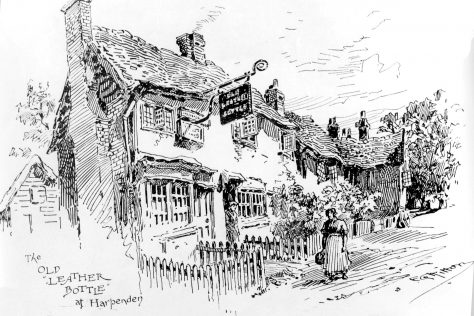
Sketch of The Old Leather Bottle
At the Leather Bottle lived Joseph Parmore, who was also a carrier. It was quite usual for a public house keeper to have another line of business. The little square house standing by the roadside, and often incorrectly referred to as the toll house, was the home of Francis Bentley and his three single daughters: they were all bonnet sewers for the hat trade.
John Henshaw, who was Headmaster of the British School, lived in a cottage nearby. He was to become known as ‘Cocky’ Henshaw, for he was a strict disciplinarian, and certainly kept the children in his care under a firm hand. His great hobby was his garden, and he invariably wore a buttonhole. His delight was to take a visitor around his garden, telling them the name of plants both by their common name and their Latin one. He took many prizes in later years at the Horticultural Shows that became a feature of Harpenden.
For neighbours, John Henshaw had a blacksmith, whose trade was a necessity to an agricultural community, and a butcher. The Slaughterhouse was behind the small butchers shop.
In this group of dwellings lived John Sanders. It was he who sold bundles of straw to the cottage women for their plaiting. He also bought back their plait, acting as a middleman to the straw plait dealer. John Sanders was also a grocer, and he sold coal in small quantities as well. Quite often he exchanged goods for an amount of plait. His home was demolished to make way for the extension of Bowers Parade in 1936.

Bowers house with skaters on the Cock Pond
At Bowers House lived Doctor Spackman and his family. Dr Spackman was the well-loved village doctor. Two of his daughters ran a small kindergarten from the house, some of the well-to-do sending their children there to receive their early education.
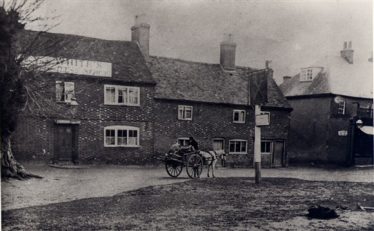
The Cross Keys – in about 1890
An agricultural implement maker’s agent lived next to the Cross Keys, where John Langham, described as Inn Keeper, was landlord. Joseph Doggett, a harness maker, had his shop by Thompson Close.
After a number of small dwellings came the home and workshop of George Huson, shoemaker. With him lived his brother, also a shoemaker, and his sister, a shoe-binder: all were unmarried. Miss Vaughan recalls in her book that he sat bent over his last in the bow window of the shoe shop, with a smile and nod to passers-by. He was ‘master’ of the Sunday School, and his tombstone records the affection which his former pupils had for him.
On the site of the present Methodist church and Library/Boots stood two breweries, both owned by widows. Mrs Elizabeth House employed six men and next door Mrs Elizabeth Healy ran the brewery later known as Glovers, which was described in a sale catalogue of 1919 as being a ‘twelve quarter brewery’.
Before Vaughan Road was thought of
Susan [Polly] Nott had a grocer’s shop where she sold groceries and sweets: this was about on the site of the entrance to Vaughan Road.
William Child, a tailor, lived next door to Henry Child, who kept the Royal Oak, which is spite of its superior name was only a beer shop. Henry Wilmott of Home Farm lived at the corner of Stakers Lane, now known as Station Road.
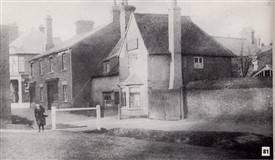
2 Southdown Road, c.1900
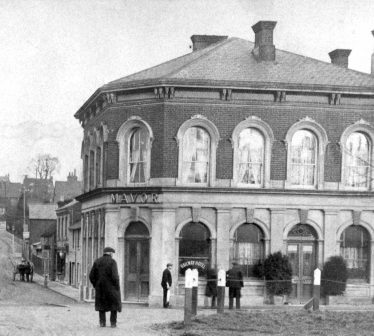
The Railway Hotel, c.1900
On the opposite corner lived James Winterborn, chemist and grocer, his neighbour being George Gardner – a master builder and glazier [at 2 Southdown Road?]
The Railway Hotel [now Harpenden Arms] was kept by Richard Longland. He presumably had travelled further afield than most of his neighbours: one of his daughters is recorded as having been born in Nicaragua. The horses kept by Richard Longland served the parish in at least two different ways. They were used to draw the carriage for wedding parties of the better-off – but not well off enough to have a carriage of their own. – and also to pull the fire appliance when required.
The only foreign name to appear in the census of 1871 was that of a gardener, Ferdinand Rosenthal, aged 26. He had been born in Kassell in Germany and now lived near Harpenden Hall.
Along Wheathampstead Road

Harpenden Hall, c.1848, when used at an Asylum
Harpenden Hall was a Lunatic Asylum: Arthur Rumball had four patients. The Asylum had been licensed in 1847 to his father, who usually had several patients under his care. The Asylum was regularly inspected by the JPs to ensure that the patients were properly looked after. One, a lady, was there for many years and died there.

Perhaps the cottages near Harpenden Hall, now site of Friends Meeting House
The cottages from Harpenden Hall to the Welcombe housed various people, including an ‘engine fitter at the works’.
Continued in a separate page on the West Side.


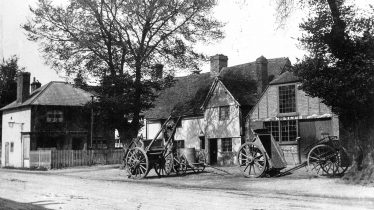
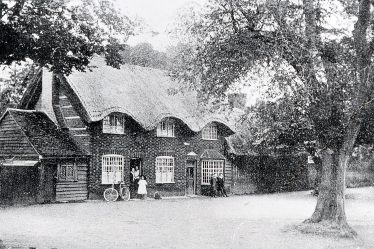
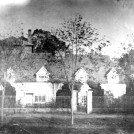
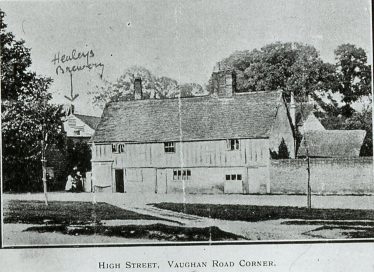
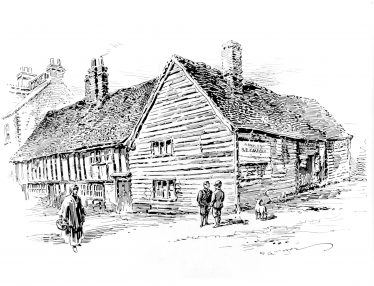
No Comments
Add a comment about this page